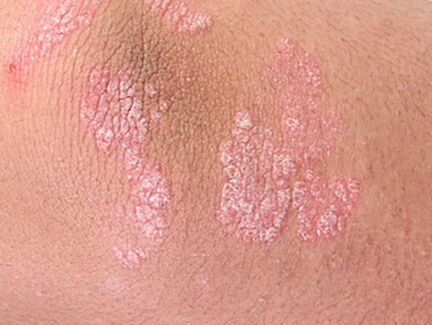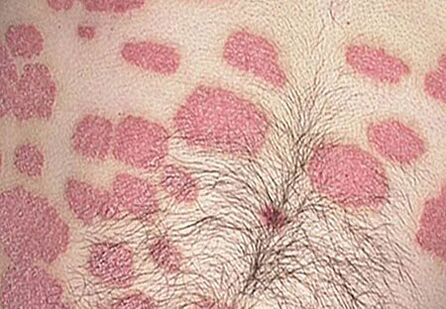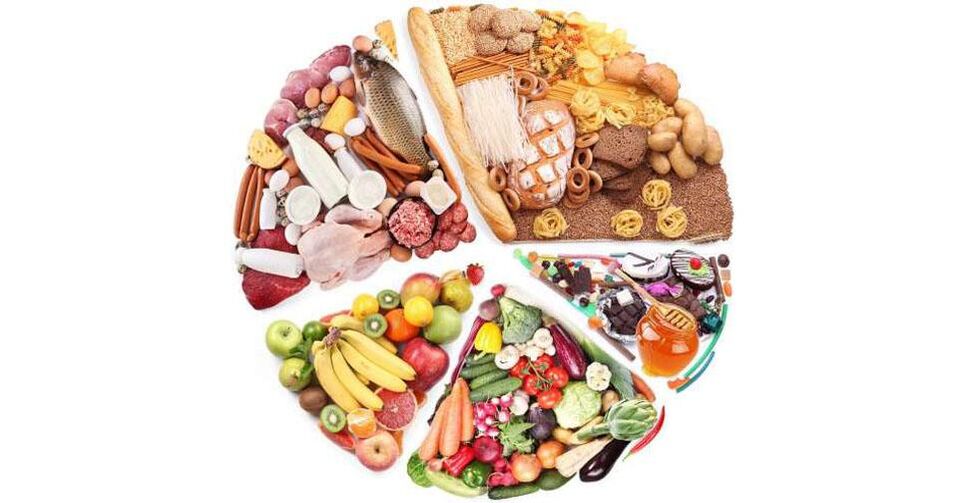What is it? Psoriasis is a disease of non -infectious skin, so it is impossible to infect. Not only does it affect the skin, it also has a negative effect on the whole body. This is characterized by a chronic course with aggravation and remission periods.
The disease is caused by immune cells in their body, ie an autoimmune disease. Rising from the depths of the skin to the upper layers, these cells cause inflammation, the excessive distribution of epidermis cells, which leads to excessive growth, the appearance of new small capillaries.
Externally looks like the formation of red or red spots - psoriasis plaques.
The first signs and symptoms of psoriasis

Because psoriasis - a systemic disease that affects all systems of the body - the patient suffers from general weakness and rapid fatigue.
The main symptom of the initial stage of psoriasis is psoriatic rashes and plaques, but accompanies the person involved in the development of the disease.
These are due to the accelerated, uncontrolled distribution of the cells in the upper layer of the skin-keratinocytes. The affected cells are formed and the skin is thickened in these areas and is red due to increased formation of new capillaries. This leads to minor drip bleeding any, even in the case of plaques injuries.
The surface of the plaques is often covered with gray raids, similar to paraffin. Even the term "paraffin lakes" was created. This plaque consists of dead epithelial cells that accumulate on the plaque's surface due to the impaired rejection process.
Spots can reach quite large sizes and merge with each other. They have a hot feeling, often with severe itching. Comys can lead to infection.
Over time, the nails begin to change. Their surfaces are cut off, pits appear, the pink spots are noticeable under the nail plate - the accumulation of the fluid, the nail is yellow, thickened, and is in the form of poultry claws. All this is due to nutrition and blood circulation violations.
Nail beds are subjected to excessive deterioration, leading to rejection of nails and loss. There is often a red inflamed boundary around the nails.
Small joints are affected by disease and small joints - this is accompanied by pain and inflammation.
Next to the plaques, beside psoriasis, the papules are formed on the skin - a small (about 1 mm) protruding formation that resembles a rash. Often localized on the elbows and knees, even during remission.
During the development, the plaques begin to light, obtain the shape of the rings and disappear completely. The pigmented areas remain in place.
The scalp psoriasis has the same symptoms as the body. In this case, the hair structure does not change. The rashes also cover the adjacent areas of the skin - behind the ears, around the neck.
Types of psoriasis
According to the symptoms, the disease is divided into two types: pustular and non -pustular. There are many types of disease in these groups.
Forms of pustular psoriasis:
- generalized;
- primarily the blow of limbs;
- Ladamary;
- scabies.
No pustule psoriasis:
- normal (chronic psoriasis);
- Erytro-Dermo.
In addition, the following types of disease are distinguished:
- Skin folds and bending surfaces psoriasis;
- drug.
Forms by severity:
- light (affects less than 3 % of the body surface);
- average (affects 10 % of the body surface);
- difficult (affects more than 10 % of surfaces).
Depending on the form of rash, this type of psoriasis can be distinguished:
- point;
- lean;
- financial.
Stages of psoriasis, symptoms

The first plaques appear in dry -skinned areas and never occur where the skin is too wet, for example, armpit. First of all, the appearance of the stains can be seen inside the elbow, under the knees, on the boundary of the hair, on the head, and in places exposed to injuries or friction. The place is usually symmetrical.
Take such sections during the disease:
- progressive (formation of new spots, existing growth, itching, noticeable peeling);
- stationary (slowing or suspension of plaques growth, lack of newly formed spots);
- Regression (lack of decrease or peeling, disappearance of stains and plaques with the appearance of pigmented skin areas in their place, and signs of psoriasis are almost missing).
There are no special tests to make the diagnosis. The diagnosis is based on external features. One of these signs is the occurrence of bleeding when the plaques come in contact with the so -called bloody dew.
Another specific sign of psoriasis is the presence of a pale border around a young papule that has not yet been covered. This is what is the vascular reaction of the skin, which is a progression of the disease.
In severe forms of the disease, blood count can change. Signs of the flowing inflammatory process appear. In some cases, you should perform a biopsy to exclude other skin diseases and strengthen the presence of psoriasis.
Effective treatment of psoriasis
In the treatment of psoriasis, both local drugs, internal, physiotherapy and medicine treatment are used.
Medicines are used in the form of ointments during the early mild course of the disease. First they use simple ointments and creams and then enter ointments containing hormones. The cream from psoriasis should only be applied to plaques and spots.
Ointment from Psoriasis: To review hormonal and non -hormonal agents
With the average and severe course, the disease is used for internal products that affect the whole body, but the best result is given. This group includes vitamin A, immunosuppressants, cytostatics.
Physiotherapists bring tangible relief for patients with psoriasis, can inhibit the onset of the disease and sometimes replace the use of some drugs.
UV irradiation (phototherapy), laser, ultrasound and magnetic, hyperthermia, electrospheres, electrophoresis, electrophoresis.
Psoriasis is able to obtain resistance over treatment over time, so it is advisable to change methods (rotation of treatment) from time to time.
Diet with psoriasis

Nutrition should help metabolism and prevents skin from appearance or worsening. Because almost all patients violate lipid metabolism, low prey products should be preferred.
The special fire and others have gained a wide reputation.
You should try to follow some simple rules when you compile your diet:
- Rejection of alcoholic beverages;
- Food 6 times a day, little by little;
- Excludes fried, smoked foods from the diet;
- Reduce the salt content of food;
- If possible, do not use products with the contents of paints, stabilizers and other nutritional supplements;
- Excludes citrus fruits;
- Increase the share of vegetables and cereals in the diet;
- Mandatory use of vegetable oils.
Adherence to these simple rules promotes psoriasis aggravation and regardless of therapeutic diet.























